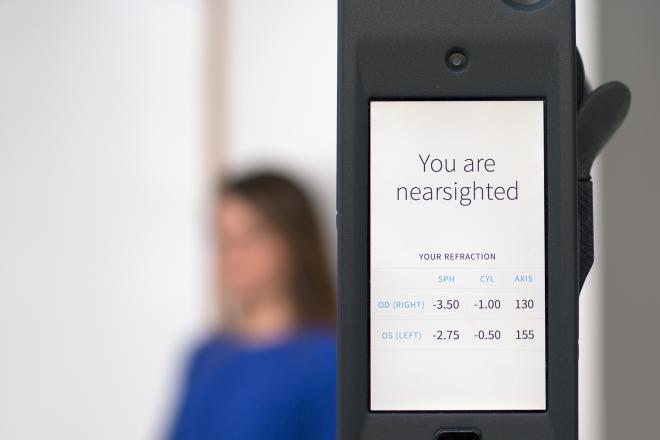When was the last time you had an eye exam? If your answer is more of an Uhhh or a scramble for additional hands to count the years, rest assured you’re not alone. But that’s not a good thing: 80 percent of all causes of visual impairment are preventable or curable, according to the World Health Organization. So what do you do when you’re not in a position, either financially or geographically or both, to regularly get your eyes checked? Two words: SVOne Enterprise. It’s a new portable eye exam from Smart Vision Labs, and it has the potential to revolutionize this aspect of health care.
Here’s how it works: People go to an optical store versus the eye doctor’s office, and stand in front of something that looks like a camera tripod. Instead of, say, a Nikon, there’s an iPhone that’s programmed with a self-guided vision test. After customers answer a few questions about their eye care, they are measured for refractive errors, including nearsightedness, farsightedness, and astigmatism; visual acuity (sharpness), and pupillary distance — the space between the eyes for glasses. Zhou explained that at the core of the technology is wavefront aberrometry, the same tech that’s been used in LASIK surgery for years.
After the test is complete, the customer’s data is sent to a “cloud of eye doctors” for review, and within 24 hours customers have a prescription sent to their email. SVL founders Yaopeng Zhou and Marc Albanese designed the tech to not only improve the flow of an eye exam, but also to help understaffed optical stores. In their research they found stores like Lenscrafters are “a soft spot” in the traditional optical industry; about 40 percent of them can’t afford to have a full-time doctor, Zhou told Medical Daily.
Launching in stores is also a way to lower the overall cost of care. The amount of money a person spends on routine check-ups, glasses, and even contacts depends on whether they have good insurance or none at all. But with SVOne, it costs $40 for an exam. Albanese said if the customer doesn’t have any insurance, they can pay the store out of pocket. Otherwise the founders charge the stores, not the customers.
During the pilot test of their tech at the State University of New York College of Optometry and various corporations across New York City, Zhou and Albanese saw first hand that it’s “kind of a mess.” Of the 700 employees they examined, roughly 25 percent wore the wrong prescription, if they wore a prescription at all. And despite 80 percent of companies providing vision insurance for employees, only 20 to 25 people used it. They would fail a DMV test, Alabanese said. Across all their pilot studies, they found the average person waits 28 months to get one exam when the recommendation is every one to two years (depending on a person’s age).
“People assume that if they see well, they don’t have an eye disease,” Dr. John A. Hovanesian, a board certified ophthalmologist on staff at the UCLA Jules Stein Eye Institute, told Medical Daily. “Without regular eye care, a disease like glaucoma or macular degeneration can blind you.”
Traditional methods, like eye dilation and testing eye pressure, can give doctors a better look at the back of the eye where disease likes to hide. But every doctor is different, and worsening vision can be an indicator of disease. The point is routine eye care, in whatever way is convenient for you, should be as important as your yearly physical.
“An exam is like a dirty pair of glasses, Hovanesian said. “When you clean them, you see much better. It affects quality of life and it’s a safety factor. You especially want sharp vision when you’re driving after dark.”
Source: Medical Daily











